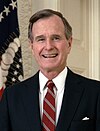| |||||||||||||||||
| |||||||||||||||||
Yarborough: 40–50% 50–60% 60–70% 70–80% 80–90% >90% Bush: 50–60% 60–70% 70–80% | |||||||||||||||||
| |||||||||||||||||
| Elections in Texas |
|---|
 |
The 1964 United States Senate election in Texas was held on November 3, 1964. Incumbent Democratic US senator Ralph Yarborough defeated future US President George H. W. Bush handily. This would prove to be Yarborough's final term as a senator. Bush later went on to win an election for the US House of Representatives in 1966 and was subsequently elected US Vice President in 1980, re-elected in 1984, and was elected president in 1988.





